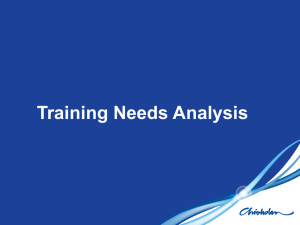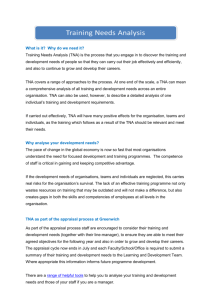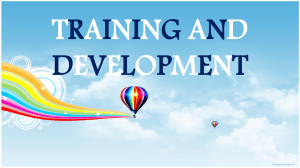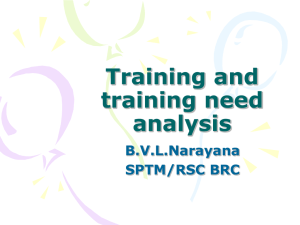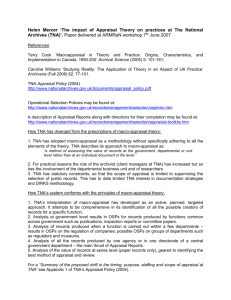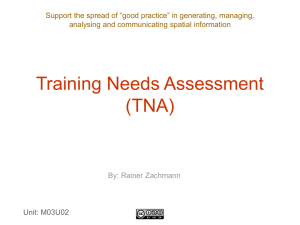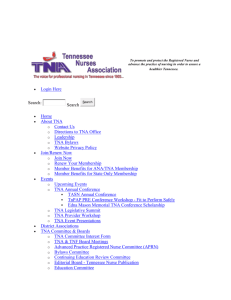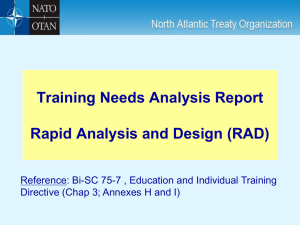Training Needs Analysis
advertisement
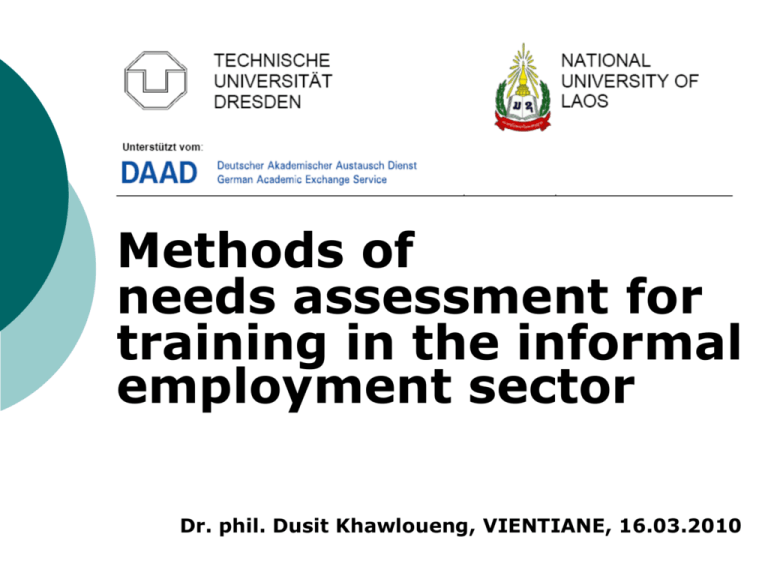
Methods of needs assessment for training in the informal employment sector Dr. phil. Dusit Khawloueng, VIENTIANE, 16.03.2010 Training Needs Analysis The boss wants some training. What is wrong in your company? Performance improvement is the focus of training. 2 Training Needs Analysis Training Needs Analysis (TNA) is a systematic method for determining what caused performance to be less than expected or required. 3 Training Needs Analysis Actual organizational performance (AOP) is the performance level of the organization, department or unit. Actual performance (AP) is the actual level of performance by an individual in the job. 4 Training Needs Analysis Note that doing needs assessment occur when actual organizational performance (AOP) is less than expected organizational performance (EOP). Organizational performance gap (OGP) 5 Training Needs Analysis The expected organizational performance (EOP) is the level or goal that has been set and is expected of the organization, department or unit in key performance areas (e.g. profits, market share, absenteeism, etc.) 6 Training Needs Analysis Expected performance (EP) is the level of performance expected of an employee holding a particular job. Organizational performance gap (OGP) is the difference between the organization’s expected performance and its actual performance on key performance indicators (e.g. profits, market share, absenteeism, etc.) 7 Training Needs Analysis We need to identify where these differences exist in terms of the problems or needs. What is causing the problem? How many meetings are ineffective? Are other issues causing the meetings to be ineffective? 8 Training Needs Analysis That is why do you conduct a training needs analysis (TNA)? You do conduct a TNA because you want to determine exactly what the deficiencies are. A TNA is important because it helps determine whether training can correct the performance problem. 9 Training Needs Analysis A TNA indicates that employees lack necessary KSAs to do the job and that they require training. Employees have KSAs to do the job, but there are roadblocks that prevent effective performance. 10 Training Needs Analysis If you conduct a TNA, you could accomplish several important things: Increase the chances that the time and money spent on training is spent wisely. Determine the benchmark for evaluation of training. 11 Training Needs Analysis If you conduct a TNA, you could accomplish several important things: Increase the motivation of participants, and Align your training activities with the company’s strategic plan. 12 Training Needs Analysis Model Input TRIGGER Actual Organizational Performance (AOP)<Expected Organizational Performance (EOP) Process Organizational Analysis Training Needs Objectives Resources Environment Operational Analysis Expected Performance (EP) Output Identify Performance Discrepancy (PD) PD = EP-AP and Cause of PD Nontraining Needs Person Analysis Actual Performance (AP) ANALYSIS PHASE (P. Nick Blanchard, and James W. Thacker, 2007, p.100) 13 Training Needs Analysis Model Trigger event. Input phase consist of an organizational analysis, an operational analysis, and a person analysis. Customer analysis 14 Training Needs Analysis Model An organizational analysis is an examination of an organization’s strategy, its goals, objectives, systems, and practices in place to determine how they affect employee performance. 15 Training Needs Analysis Model An operational analysis is an examination of specific jobs to determine the requirements in term of the tasks required to be done, and the KSAs required to get the job done. Job analysis or task analysis. 16 Training Needs Analysis Model A person analysis is an examination of the employees in the jobs to determine whether they have the required KSAs to perform at the expected level. 17 Training Needs Analysis Model A customer analysis is an examination of the customers’ needs, expectation to determine whether they like or unlike for evaluation the quality of service. 18 Training Needs Analysis Model In the process phase, the operational analysis provided information on expected performance. Expected performance (EP) is the level of performance expected in a particular job. 19 Training Needs Analysis Model The person analysis provides information on actual performance. Actual performance (AP) is the current level of performance by an individual on a particular job. 20 Training Needs Analysis Model The difference between actual organizational performance and expected performance is called an organizational performance gap. The difference between actual and expected performance obtained from the operational and person analysis of the TNA is simply termed a performance gap. 21 Training Needs Analysis Model The output phase is your conclusion as whether the PG indicates either training or non-training needs, and in some cases, both. 22 Types of TNA Reactive TNA is a type of TNA that focuses on a performance problem that current exists. Proactive TNA is focusing on a performance problem anticipated in the future. 23 The Framework for Conducting a TNA Organizational analysis Operational analysis Person analysis Customer analysis 24 The Framework for Conducting a TNA Organizational analysis involves looking at the internal environment of the organization, influences that could affect employee performance, and determining its fit with organizational goals and objectives. It is this analysis that provides identification of PD at the organizational level. 25 The Framework for Conducting a TNA The organizational analysis is also an examination of how the internal environment affects job performance. Finally, the organizational analysis identifies constraints on training. 26 The Framework for Conducting a TNA Organizational analysis - The mission and strategies, - The resources and allocation of the resources, given the objectives, - The factors in the internal environment and, - The other factors that facilitate an employee’s ability to meet job performance expectation. 27 The Framework for Conducting a TNA Operational analysis examines specific jobs to determine the requirements (KSAs) necessary to get the job done (i.e. expected job performance). This process is generally called a job analysis or task analysis 28 The Framework for Conducting a TNA And it requires an extensive analysis of a job to determine all the tasks necessary to perform the job at the expected level. After all tasks are identified, the next step is to determine the KSAs necessary to perform each of the tasks. 29 The Framework for Conducting a TNA Each tasks needs to be examined by asking the question, what knowledge, skills, attitudes are necessary to be able to perform this task at the expected level? The KSAs obtained from the analysis are the ones that an incumbent have to perform at the expected level. 30 The Framework for Conducting a TNA Job analysis KSAs - Knowledge - Skill - Attitude 31 The Framework for Conducting a TNA Person analysis examine those who occupy the jobs to see whether they posses the require KSAs necessary to do the job. Here we measure the actual job performance of those on the job to see whether they are performing at an acceptable level. 32 The Framework for Conducting a TNA This task might seem easy enough; simply look at the supervisor’s appraisal of the incumbents. Other methods are also used to obtain this type of information for example, asking incumbents themselves, or asking coworkers. 33 The Framework for Conducting a TNA Person analysis Expected performance – Actual performance = Performance gap Performance Appraisal Self-Ratings Behavioral Tests Attitude Measures 34 The Framework for Conducting a TNA Customer analysis - Survey in cycle of service - Survey by questionnaire, interview, observation. - Study and survey in expectation of customer about the service that they need to find the organizational deficiency. 35 Output of TNA Training-needs Non-Training Needs Non-Training Needs that have no KSA Deficiency reward/punishment incongruence Inadequate or inappropriate feedback and/or Obstacles in the system 36 Output of TNA Non-Training Needs Non-Training Needs that have KSA Deficiency Job-Aids Practice Changing the Job Itself Training needs 37 Thank you for your attention. Dr. phil. Dusit Khawloueng, VIENTIANE, 16.03.2010
